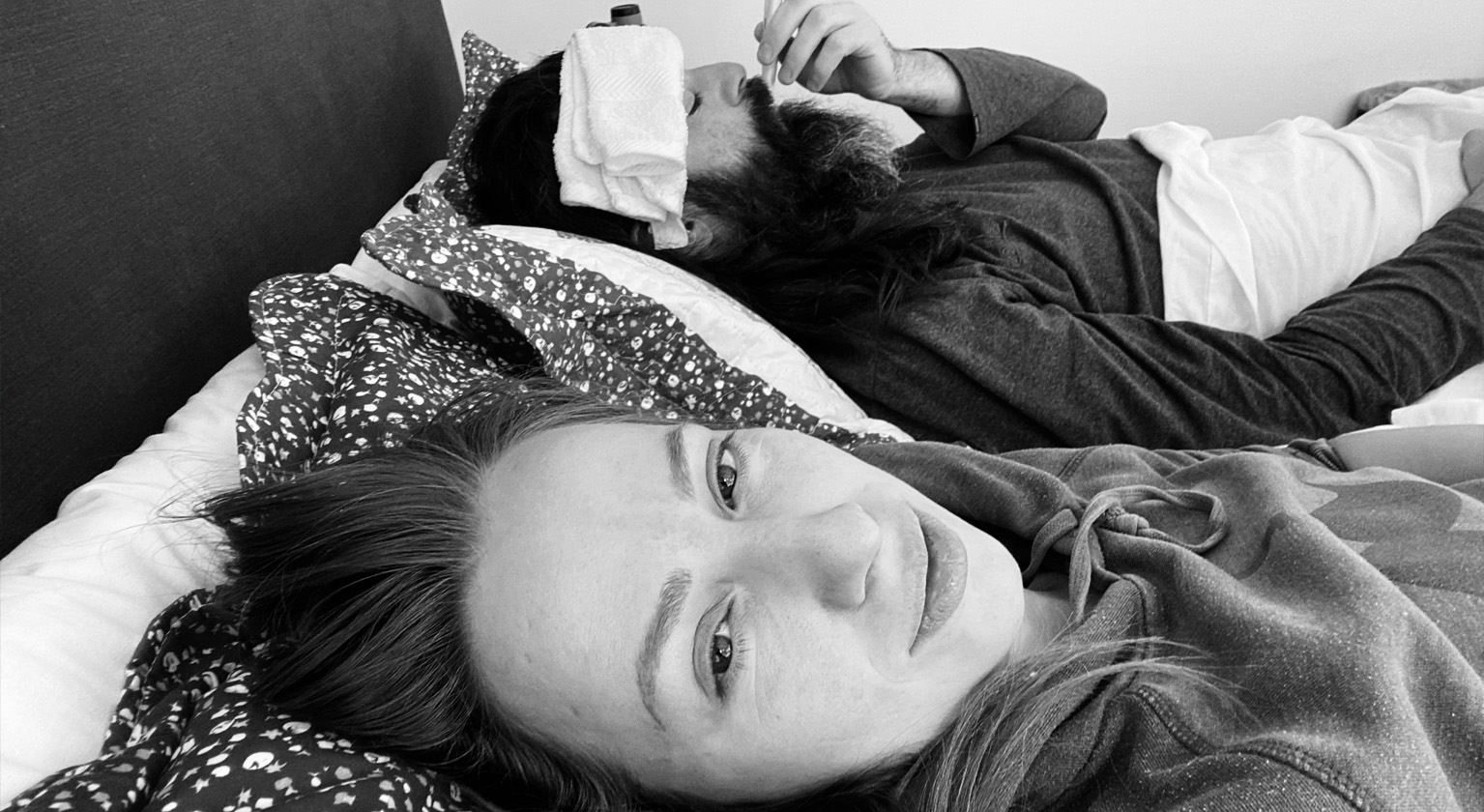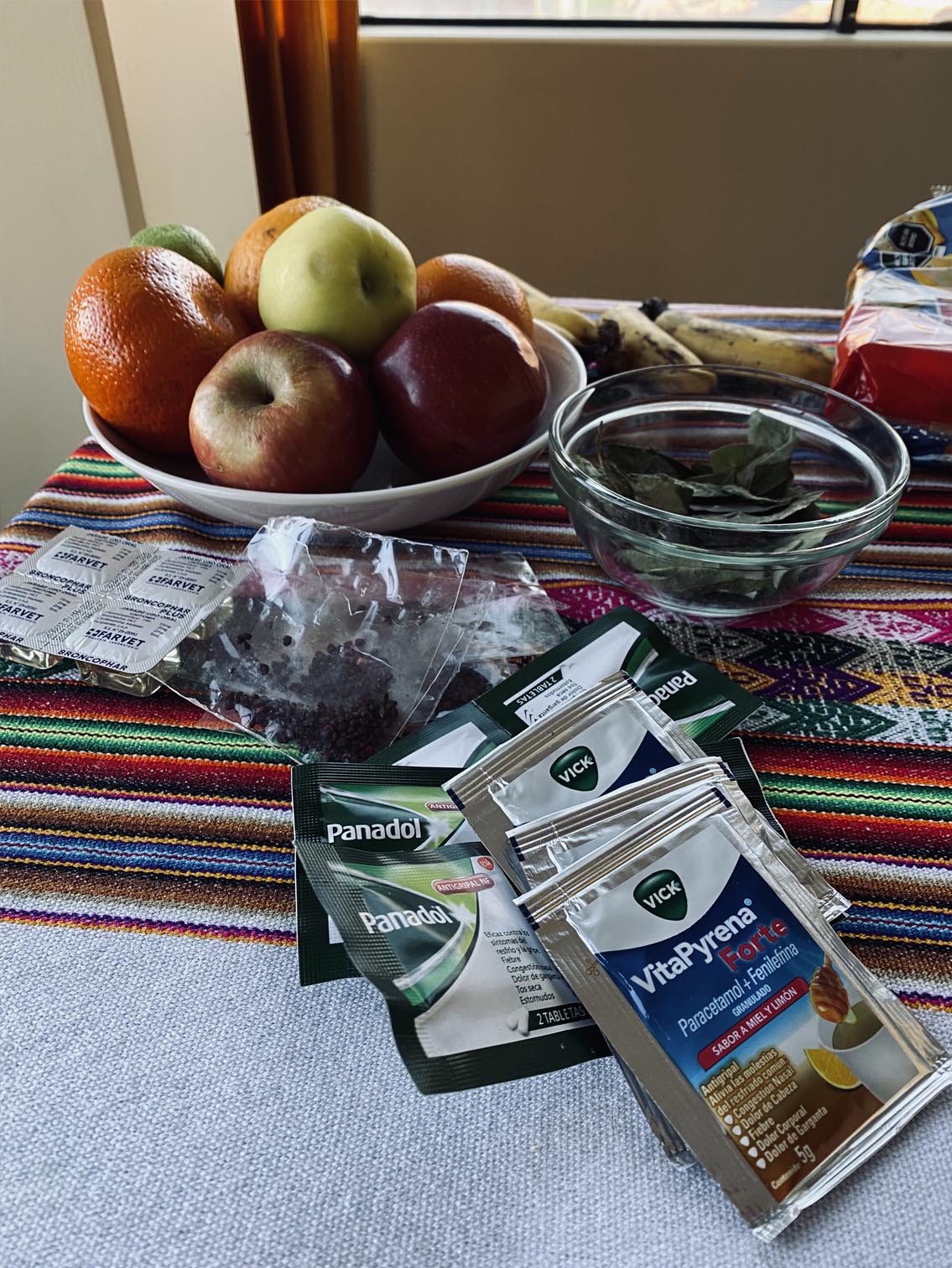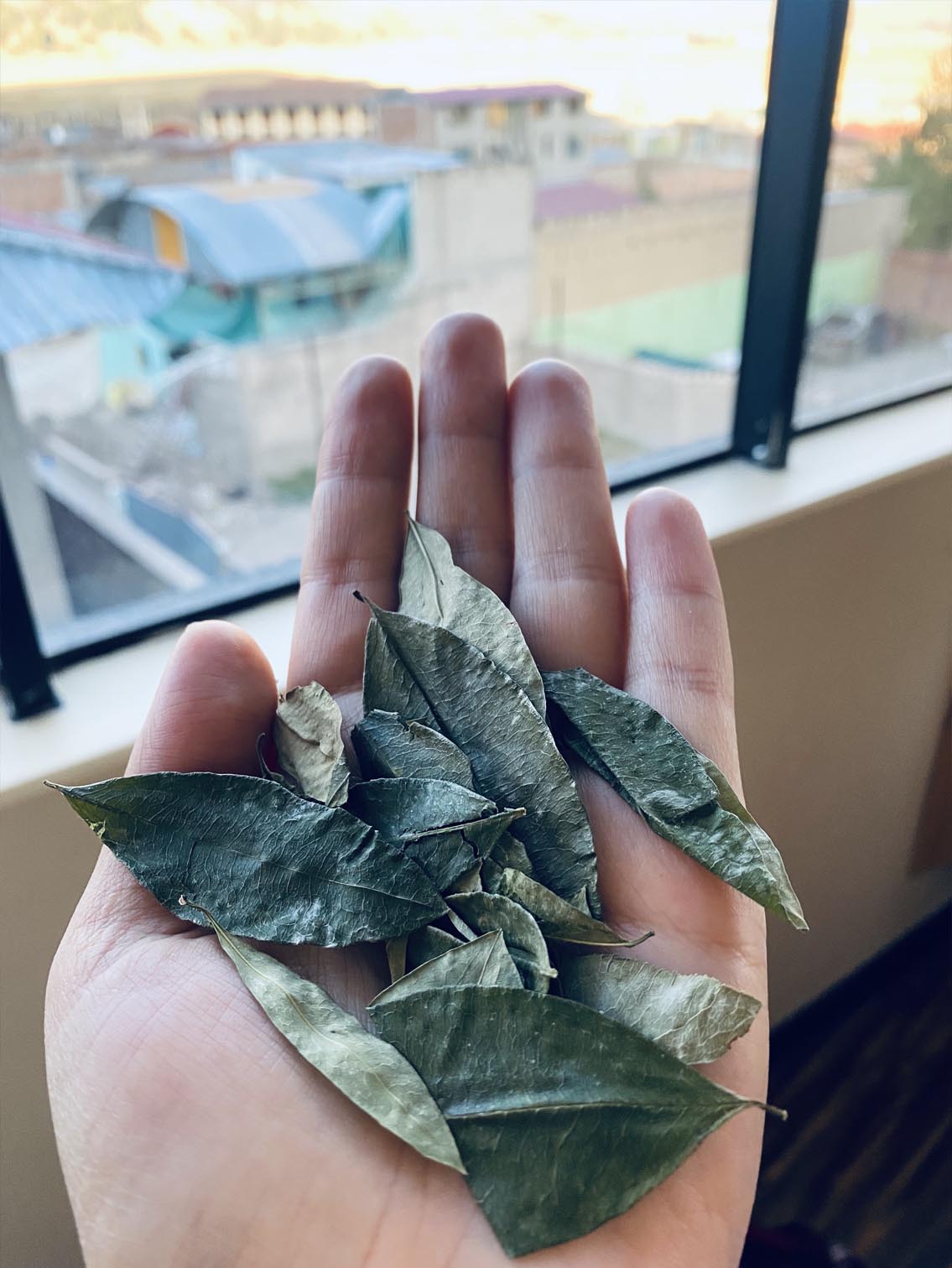Jenia’s Herbal Remedies

The High Andes between Peru and Bolivia are home to some of the world’s highest cities. Many of these cities rest higher than 3,000 metres and thin air can affect the body in many ways that no one can predict.
In Peru, down at sea level, I opened the doors of the kitchen cabinets in our apartment for the first time and was hit with the stale, dank, smell of mould. There is a miasma that clings to the Peruvian coast that cannot be explained but, in Lima, if the sea is in view, then the sun is not. The air is cold and wet and the laundry never fully dries. Jenia and I disagreed about where our illnesses came from and about how to deal with them and, throughout our two-month-long trip across the highest part of the Andes, we battled through a series of health complications beginning with that deep breath of bad air from the kitchen cabinets.
 Fever hit me in the evening and had me running to the toilet for relief. Jenia, in a daze of her own, but acting brave, ran errands and nursed me the next day as I lay shivering in bed. For fever, I trusted regular, over-the-counter, Paracetamol. For gastrointestinal distress, I believed that the body simply needed to rid itself of whatever the offending microorganism was and my strategy was to stay hydrated while riding it out. Before we ever got sick in South America, Jenia explored the local markets along our route searching for local herbs and strange tonics. Jenia distrusted the pharmaceutical industry and was proactive about her health. She believed that a healthy immune system was built daily from within with good habits and a health-promoting diet rather than cured from without by a pill. She urged me to swallow heaping spoonfuls of what she called “smekta” – a white paste of bentonite clay used as a binder to rid the body of offending toxins. Bed rest and time are the surest remedies for any condition and I believed in my methods for alleviating the associated discomforts. Chugging a flavourless glue seemed like adding to the discomfort and a last resort, but Jenia could become so insistent that I would plug my nose and force it down to make her happy and let me sleep.
Fever hit me in the evening and had me running to the toilet for relief. Jenia, in a daze of her own, but acting brave, ran errands and nursed me the next day as I lay shivering in bed. For fever, I trusted regular, over-the-counter, Paracetamol. For gastrointestinal distress, I believed that the body simply needed to rid itself of whatever the offending microorganism was and my strategy was to stay hydrated while riding it out. Before we ever got sick in South America, Jenia explored the local markets along our route searching for local herbs and strange tonics. Jenia distrusted the pharmaceutical industry and was proactive about her health. She believed that a healthy immune system was built daily from within with good habits and a health-promoting diet rather than cured from without by a pill. She urged me to swallow heaping spoonfuls of what she called “smekta” – a white paste of bentonite clay used as a binder to rid the body of offending toxins. Bed rest and time are the surest remedies for any condition and I believed in my methods for alleviating the associated discomforts. Chugging a flavourless glue seemed like adding to the discomfort and a last resort, but Jenia could become so insistent that I would plug my nose and force it down to make her happy and let me sleep.
We changed apartments in Lima and it was Jenia’s turn to suffer as she complained about having a stuffed nose and a sore throat. By the time we left Lima and continued south to Huacachina, the illness bounced over to me it was my turn with a sore throat. The fever and the dizziness had passed so I could keep my head but a thousand knives of fire felt as though they were slowly cutting through my Adam’s apple. It became difficult to enjoy a meal and I consumed hefty amounts of whatever soothing lozenges I could find, all the while complaining bitterly that Fisherman’s Friend was nowhere to be found in any pharmacy.
By the time we reached Nazca, both Jenia and I were brewing local herb teas and sipping honey to coat our throats. We scoured the local markets stocking up on fresh citrus fruit hoping that high doses of vitamin C would lead us on the path to better health. After turning around to head back north to Pisco to connect with the route Eastward leading to the mountains, we were beginning to feel like ourselves again, but two miserable weeks had passed with each of us falling back on our respective health protocols while undermining the other’s methods.
The climb into the mountains begins gradually and the route is more or less straight. But, by the time we arrived in Huaytara, the scenery had changed from the dull grey coast to the sunny and dramatic rocky landscapes of the mountains. Roads begin to wind around the mountainsides from Ayacucho through Andahuaylas and Abancay before the tops of the mountains begin to level out into their plateau around Cusco.
Most tourists fly into Cusco from Lima and it is not uncommon to see restaurant reviews of people complaining of a meal leaving their body soon after ingestion. Most are followed by a counter-review from the proprietor reminding disgruntled diners to eat with caution after arriving so suddenly at altitude. No matter the meal, both Jenia and I found our appetites waning after just a few bites.
Various work-related stresses crept into our lives and put their own strain on our relationship. We were on a quest, not a vacation, and not every day was rosy or met with wide smiles. There were occasions where Jenia and I, having skipped past casual dating to living our occasionally separate lives between Tranquilo and the next hotel, simply tolerated each other. Our remedy for these moments, even if in the moment we hated the sight of the other person, was to put our computers aside and lay down quietly together to feel a moment of peace. In the worst of times, one of us found the serenity to demand a pause and would state that it was time to share 10 good things about the other person to which the other was forced to oblige.
Tranquilo had suffered her share of breakdowns and, though we did not hike the Inca trail, any visit to Machu Picchu involves covering a lot of ground on foot. When we returned to Cusco, I bought massages for Jenia and myself. We had entered a new stage of our quest. The euphoria of those first steps seemed long behind us and the road yet to travel seemed impossibly long. More than the massage, we both needed to feel like we were worth pampering. It was during our massage that we were introduced to Agua de Florida for the first time. Agua de Florida is an aromatic tonic made from a blend of citrus, ylang-ylang, and other herbs. Rubbing just a few drops into the palms of one’s hands to then breathe in deeply is both calming and bright and able to lift one’s mood.
Our muscles, now relaxed, had barely had time to settle when Jenia spiked a fever in a small town called San Pedro where we had only expected to stay a single night on our way to visit the rainbow mountain of Vinicunca. The next day, I spiked my own fever and joined her unable to get out of bed. The hotel allowed us to extend our stay and the manager, Gabriella, nursed us back to health over 5 days.  Every day, Gabriella would bring us hot teas and replenish our supply of coca leaves that we chewed to combat the altitude’s war on our bodies. She gave us a bottle of Agua de Florida and introduced us to an Andean remedy called ayrampu. Ayrampu is made from a local plant, the seeds of which are covered with boiling water and made into a hot drink to combat fever. Jenia swore that it could not but I was certain that somewhere we had contracted COVID. If not here in Cusco, then our illnesses in Lima, I was convinced that COVID had reared its ugly head at least once. Jenia maintained that mould, bad air, and altitude were the causes of our ailments.
Every day, Gabriella would bring us hot teas and replenish our supply of coca leaves that we chewed to combat the altitude’s war on our bodies. She gave us a bottle of Agua de Florida and introduced us to an Andean remedy called ayrampu. Ayrampu is made from a local plant, the seeds of which are covered with boiling water and made into a hot drink to combat fever. Jenia swore that it could not but I was certain that somewhere we had contracted COVID. If not here in Cusco, then our illnesses in Lima, I was convinced that COVID had reared its ugly head at least once. Jenia maintained that mould, bad air, and altitude were the causes of our ailments.
During our extended stay in that tiny town, we happened upon some merchants selling local remedies in recycled plastic bottles in the town square. Jenia was determined to walk away with something to combat the now pervasive altitude sickness and convinced me to buy a strange potion that, at first, we thought we were supposed to take orally but were instructed that the foul-smelling liquid inside was supposed to be applied topically. We had that bottle for weeks but by default reverted to the Agua de Florida by virtue of the fact that it smelled so much better. Eventually, after so many hours in the car and on hikes, we began to develop sore muscles and cuts of a thousand varieties and finally turned to the strange liquid in that plastic bottle. I can’t rightly say, scientifically, what was in that bottle, but spiritually it was magic.
When we got our strength back, we travelled from San Pedro and climbed to the top of Vinicunca whose summit is over 5,000 metres. The distance from the parking lot to the top is only about 2 kilometres but it takes well over an hour to walk because the ascent is slow. It is difficult to get more than 100 metres without needing to stop to catch one’s breath. Locals stand at the ready with ATVs or horses to shepherd tourists to the summit. Even those who complete the hike with help find it difficult to cope when they reach the top. Some folks just break down into tears unable to put one foot in front of the other. For a couple of dollars, visitors can sample an alpaca stew that locals serve. There is an initial theory that having a bite to eat will provide enough energy to help a hiker carry on, but it is wild meat and, during my one-time trek, I witnessed a half-dozen people puking it up. Near the summit, I met one intrepid, 22-year-old, Belgian hiker who made the ascent on crutches and whose way to cope with the altitude was to crack open a beer at 11 am, so you never know.
After six weeks of battling colds and flu in Peru, we soldiered on into Bolivia where the wrong meal on the wrong day had us stuck in a hotel in La Paz for days longer than we expected with some sort of bacterial infection. In small villages along the way, meals at trusted restaurants simply are not an option. Food from the street, though a gamble by standards of cleanliness, is delicious and, at least in the moment, can seem worth the risk. Coming from Canada where all of our is irradiated with chemicals that wipe out potential pathogens and flavour from the food, I had become lazy with my personal hygiene. The mood was not always friendly between us and, in the moments of our worst illnesses, I also had to contend with Jenia wagging her accusing finger at me for not being adequately vigilant in washing my hands before eating. Wiping myself down in alcohol is just something that I have never developed the proper presence of mind for while at the same time, I rarely pass up the opportunity to be friendly with stray dogs and cats. The potential for possession by the most offensive pathogen eventually caught up with us and, after two days spent between the bed and the toilet, even Jenia gave in and surrendered to Western medicine. Antibiotics may not be the path to good health but they can be a Godsend for fighting off some of the most frightening maladies that Mother Nature can throw at you.
Anywhere over 3,000 metres the body is never safe. Every part of you feels heavy and you can feel your blood curdling like yogurt and getting trapped in your veins. With blood unable to get where it needs to, any part of the body that endures any amount of stress begins to scream with inflammation. Even the fanciest meal at a ritzy restaurant or a bowl of plain rice can put every measure of bodily immunity on high alert as every molecule of bacteria, scrambling for more oxygen, fights to sustain itself. The ubiquitous Andean tableside remedy for the gurgles is a yellow-hued sugary soda called Inca Cola. Although Inca Cola is the preferred brew of locals, regular old Coca-Cola, ginger ale, or anything with bubbles will help to alleviate the worst case of post-meal gut rot. Nine times out of ten, Jenia and I would opt for a healthier, sugar-free, beverage alternative. But at high altitude, all bets are off and you do what you can to stay well.